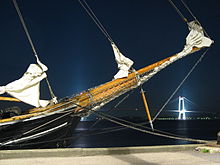bowsprit

The (regional also) bowsprit ( / buːkˌʃpriːt / ) is a traditional fixed to the hull of a sailing vessel is connected, via the stem or the Galion protruding strong spar . Today the bowsprit mostly only serves as an anchor bracket.
Historic sailing ships
Historically, the forestay is attached to the bowsprit to support the foremast . The bowsprit usually protrudes centrally at an acute angle to the horizontal in the fore and aft direction of the bow . In the case of smaller vehicles, it can also be arranged horizontally and decentrally. Bowsprits used to be made of wood, from the 19th century hollow bodies made of steel or aluminum were also used.
On larger ships , the bowsprit is connected to another spar, the jib boom , via a donkey 's head. The jib boom was retractable on some sailors. A bowsprit and jib boom combination made from a piece of sheet steel is called a pile bowsprit. He can be found on Windjammer . One or more staysails can be driven between foremast and bowsprit or jib boom . At the bowsprit, tamping days usually begin to balance out forces . A safety net is often stretched under the bowsprit.
In some historical sailing ship types, one or two square sails , blind and upper blind , were set under the bowsprit . A small square sail with the designation Oberblinde was also driven on a possible sprietmast, a small mast placed on the bowsprit . Bowsprits of historical ship types such as galleons and frigates usually had a significantly larger angle to the horizontal than those of later sailors.
Modern yacht building

Today's sailing yachts have neither a classic bowsprit nor a jib boom. The bowsprit is now the metal bow extension on which the bow anchor is kept. With the anchor winch just behind the bow, the anchor can be raised and lowered, but remains in its hawse during the journey and in port. The bowsprit usually also serves as a step when the bow is placed against the jetty. The forestay - usually equipped with a furling system - is attached just behind the bow over the bowsprit.
Racing yachts in particular often have an extendable spar at the bow or just below it, to which the neck of an asymmetrical downwind sail ( gennaker or blister ) is attached. Accordingly, this is called the gennaker tree or blister nose.
Individual evidence
literature
- Schult, Joachim: Segler-Lexikon. Bielefeld: Delius Klasing, (13th edition) 2008, ISBN 3-87412-103-8

